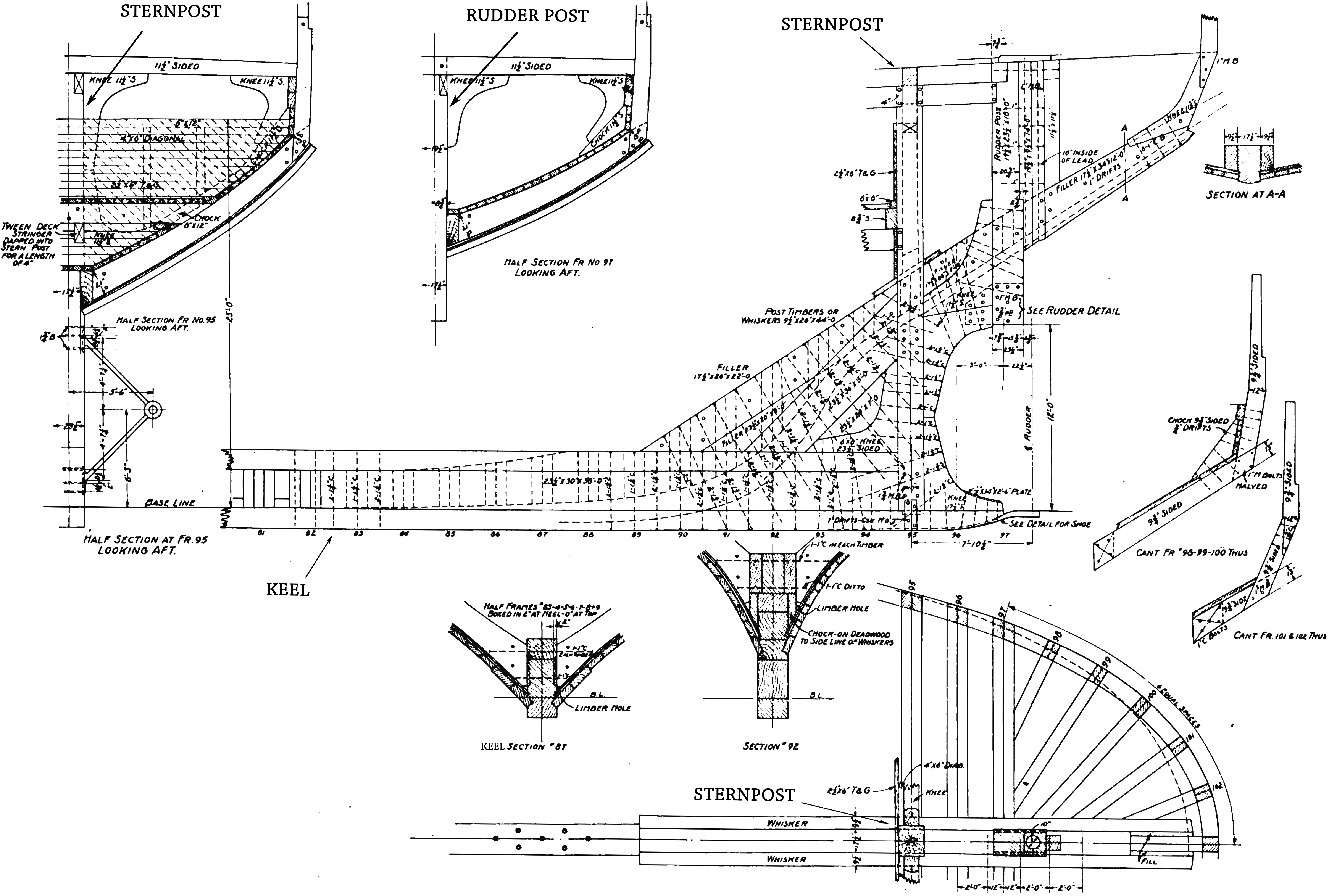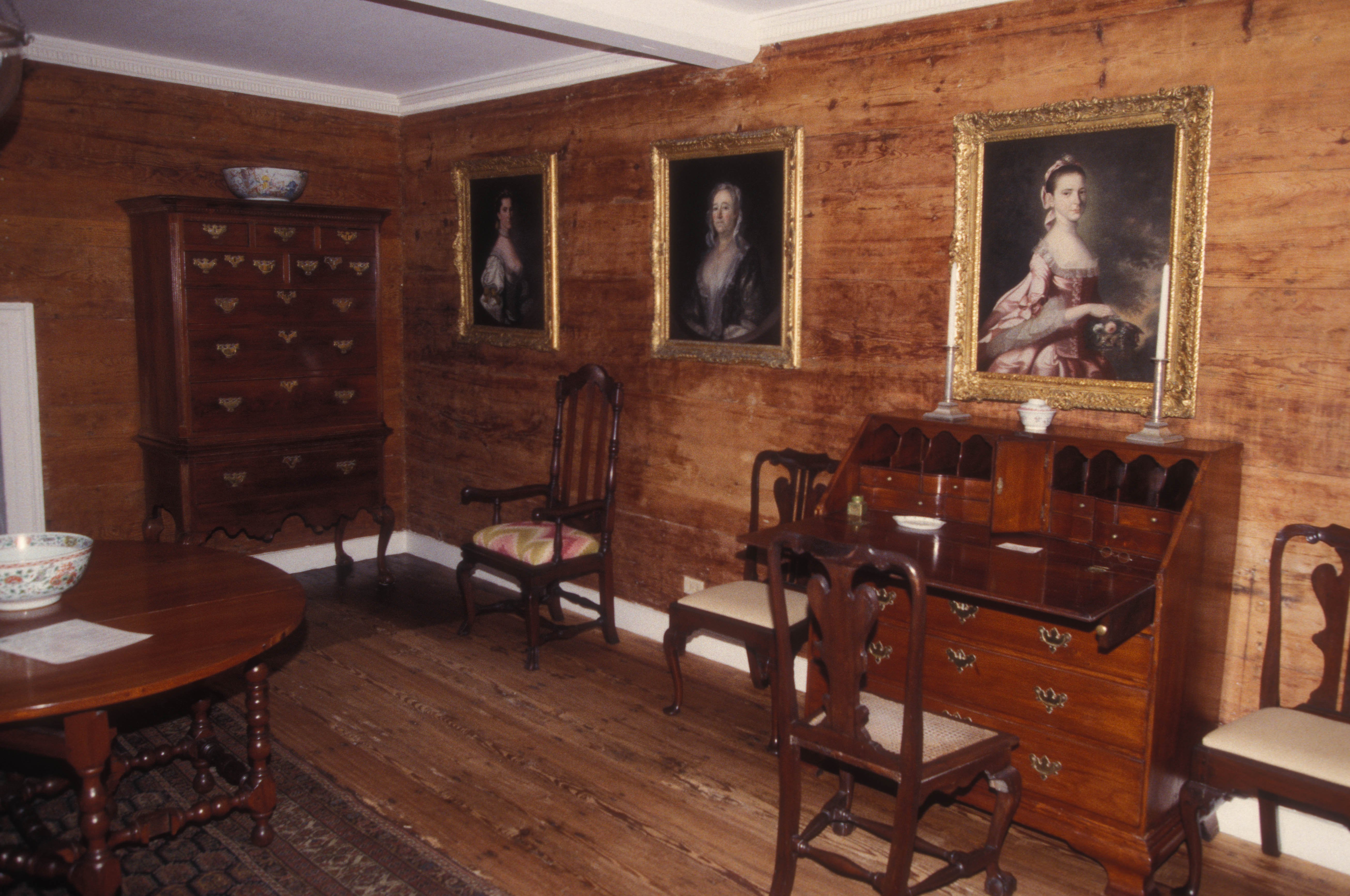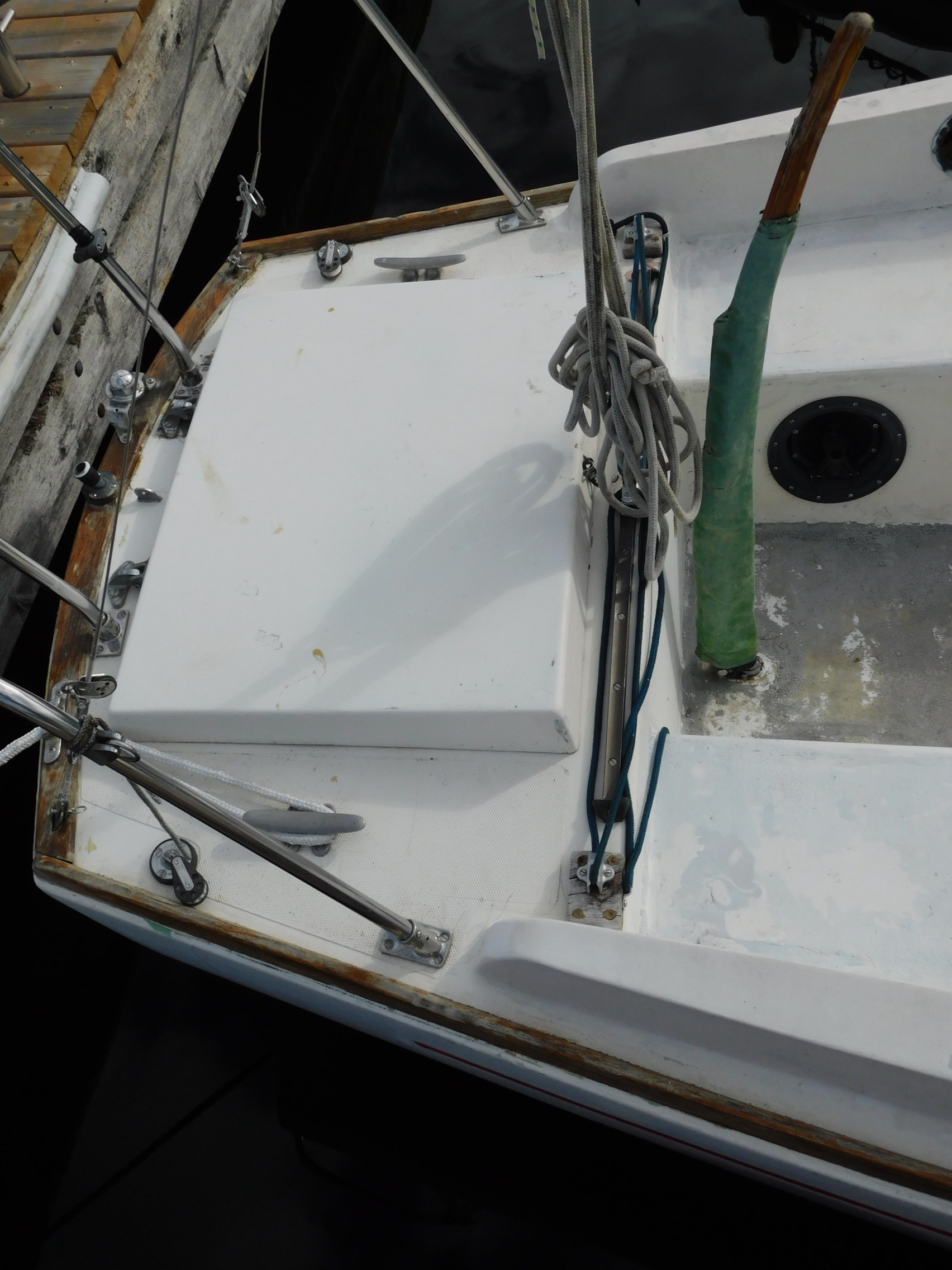|
Transom (nautical)
In some boats and ships, a transom is the aft transverse surface of the hull that forms the stern of a vessel. Historically, they are a development from the canoe stern (or "double-ender") wherein which both bow and stern are pointed. Transoms add both strength and width to the stern. They may be flat or curved and they may be vertical, raked forward (known as retroussé), or raked aft. In small boats and yachts, this flat termination of the stern is typically above the waterline, but large commercial vessels often exhibit vertical transoms that dip slightly beneath the water. On cruising boats, a counter stern may be truncated to form a "truncated counter stern", in which there is a part of the stern that approximates a transom. Although that standard stern transom is typically vertical, they may be raked such that there is an overhang above the water, as at the bow. A reverse transom is angled from the waterline forwards. On smaller boats such as dinghies, transoms may be ... [...More Info...] [...Related Items...] OR: [Wikipedia] [Google] [Baidu] |
Stern Of Bro Elisabeth
The stern is the back or aft-most part of a ship or boat, technically defined as the area built up over the sternpost, extending upwards from the counter rail to the taffrail. The stern lies opposite the bow, the foremost part of a ship. Originally, the term only referred to the aft port section of the ship, but eventually came to refer to the entire back of a vessel. The stern end of a ship is indicated with a white navigation light at night. Sterns on European and American wooden sailing ships began with two principal forms: the ''square'' or ''transom'' stern and the ''elliptical'', ''fantail'', or ''merchant'' stern, and were developed in that order. The hull sections of a sailing ship located before the stern were composed of a series of U-shaped rib-like frames set in a sloped or "cant" arrangement, with the last frame before the stern being called the ''fashion timber(s)'' or ''fashion piece(s)'', so called for "fashioning" the after part of the ship. This frame is ... [...More Info...] [...Related Items...] OR: [Wikipedia] [Google] [Baidu] |
Latin
Latin ( or ) is a classical language belonging to the Italic languages, Italic branch of the Indo-European languages. Latin was originally spoken by the Latins (Italic tribe), Latins in Latium (now known as Lazio), the lower Tiber area around Rome, Italy. Through the expansion of the Roman Republic, it became the dominant language in the Italian Peninsula and subsequently throughout the Roman Empire. It has greatly influenced many languages, Latin influence in English, including English, having contributed List of Latin words with English derivatives, many words to the English lexicon, particularly after the Christianity in Anglo-Saxon England, Christianization of the Anglo-Saxons and the Norman Conquest. Latin Root (linguistics), roots appear frequently in the technical vocabulary used by fields such as theology, List of Latin and Greek words commonly used in systematic names, the sciences, List of medical roots, suffixes and prefixes, medicine, and List of Latin legal terms ... [...More Info...] [...Related Items...] OR: [Wikipedia] [Google] [Baidu] |
Watercraft Components
A watercraft or waterborne vessel is any vehicle designed for travel across or through water bodies, such as a boat, ship, hovercraft, submersible or submarine. Types Historically, watercraft have been divided into two main categories. *Rafts, which gain their buoyancy from the fastening together of components that are each buoyant in their own right. Generally, a raft is a "flow through" structure, whose users would have difficulty keeping dry as it passes through waves. Consequently, apart from short journeys (such as a river crossing), their use is confined to warmer regions (roughly 40° N to 40° S). Outside this area, use of rafts at sea is impracticable due to the risks of exposure to the crew. *Boats and ships, which float by having the submergeable part of their structure exclude water with a waterproof surface, so creating a space that contains air, as well as cargo, passengers, crew, etc. In total, this structure weighs less than the water that would occupy the sa ... [...More Info...] [...Related Items...] OR: [Wikipedia] [Google] [Baidu] |
Sailboat Components
A sailboat or sailing boat is a boat propelled partly or entirely by sails and is smaller than a sailing ship. Distinctions in what constitutes a sailing boat and ship vary by region and maritime culture. Types Although sailboat terminology has varied across history, many terms have specific meanings in the context of modern yachting. A great number of sailboat-types may be distinguished by size, hull configuration, keel type, purpose, number and configuration of masts, and sail plan. Popular monohull designs include: Cutter The cutter is similar to a sloop with a single mast and mainsail, but generally carries the mast further aft to allow for two foresails, a jib and staysail, to be attached to the head stay and inner forestay, respectively. Once a common racing configuration, today it gives versatility to cruising boats, especially in allowing a small staysail to be flown from the inner stay in high winds. Catboat A catboat has a single mast mounted far forward ... [...More Info...] [...Related Items...] OR: [Wikipedia] [Google] [Baidu] |
Hull (watercraft)
A hull is the watertight body of a ship, boat, submarine, or flying boat. The hull may open at the top (such as a dinghy), or it may be fully or partially covered with a deck. Atop the deck may be a deckhouse and other superstructures, such as a funnel, derrick, or Mast (sailing), mast. The line where the hull meets the water surface is called the waterline. General features There is a wide variety of hull types that are chosen for suitability for different usages, the hull shape being dependent upon the needs of the design. Shapes range from a nearly perfect box, in the case of scow barges, to a needle-sharp surface of revolution in the case of a racing multihull sailboat. The shape is chosen to strike a balance between cost, hydrostatic considerations (accommodation, load carrying, and stability), hydrodynamics (speed, power requirements, and motion and behavior in a seaway) and special considerations for the ship's role, such as the rounded bow of an icebreaker or the flat bot ... [...More Info...] [...Related Items...] OR: [Wikipedia] [Google] [Baidu] |
Spirit Of Bermuda
''Spirit of Bermuda'' is a modern-built Bermuda sloop. She is a replica of a Royal Navy sloop-of-war, depicted in a well-known 1831 painting. History of the Bermuda sloop The Bermuda sloop was a type of small sailing ship built in Bermuda between the seventeenth and nineteenth centuries. Fitted with a gaff rig, a combination of gaff and square rig, or Bermuda rig, they were used by Bermudian merchants, privateers and other seafarers. Their versatility, and their manoeuvrability and speed, especially upwind, meant they were also jealously sought after by non-Bermudian operators for both merchant and naval roles. Bermudians built large numbers of them for their own merchant fleet and for export before being obliged to turn to other trades in the nineteenth century. At the end of the twentieth century, no Bermuda sloop remained anywhere in the world, and most Bermudians had no practical or romantic connection to the island's long history as a maritime economy. These were among t ... [...More Info...] [...Related Items...] OR: [Wikipedia] [Google] [Baidu] |
Juniperus Bermudiana
''Juniperus bermudiana'' is a species of juniper endemic to Bermuda. This species is most commonly known as Bermuda cedar, but is also referred to as Bermuda juniper ( Bermudians refer to it simply as ''cedar''). Historically, this tree formed woodland that covered much of Bermuda. Settlers cleared part of the forest and the tree was used for many purposes including building construction and was especially prized for shipbuilding. Scale insects introduced during the Second World War construction of United States airbases in Bermuda devastated the forests, killing over 99% of the species (an event known in Bermuda as 'the Blight' or 'the Cedar Blight'). Since then, the salt tolerant ''Casuarina equisetifolia'' has been planted as a replacement species, and a small number of Bermuda cedars have been found to be resistant to the scale insects. Populations of certain endemic birds which had co-evolved with the tree have plummeted as a result of its demise, while endemic cigalas (or ... [...More Info...] [...Related Items...] OR: [Wikipedia] [Google] [Baidu] |
Old French
Old French (, , ; ) was the language spoken in most of the northern half of France approximately between the late 8th [2-4; we might wonder whether there's a point at which it's appropriate to talk of the beginnings of French, that is, when it was deemed no longer make to think of the varieties spoken in Gaul as Latin. Although a precise date can't be given, there is a general consensus (see Wright 1982, 1991, Lodge 1993) that an awareness of a vernacular, distinct from Latin, emerged at the end of the eighth century.] and mid-14th centuries. Rather than a unified Dialect#Dialect or language, language, Old French was a Dialect cluster, group of Romance languages, Romance dialects, Mutual intelligibility, mutually intelligible yet Dialect continuum, diverse. These dialects came to be collectively known as the , contrasting with the , the emerging Occitano-Romance languages of Occitania, now the south of France. The mid-14th century witnessed the emergence of Middle French, the lang ... [...More Info...] [...Related Items...] OR: [Wikipedia] [Google] [Baidu] |
Middle English
Middle English (abbreviated to ME) is a form of the English language that was spoken after the Norman Conquest of 1066, until the late 15th century. The English language underwent distinct variations and developments following the Old English period. Scholarly opinion varies, but the University of Valencia states the period when Middle English was spoken as being from 1150 to 1500. This stage of the development of the English language roughly coincided with the High Middle Ages, High and Late Middle Ages. Middle English saw significant changes to its vocabulary, grammar, pronunciation, and orthography. Writing conventions during the Middle English period varied widely. Examples of writing from this period that have survived show extensive regional variation. The more standardized Old English literary variety broke down and writing in English became fragmented and localized and was, for the most part, being improvised. By the end of the period (about 1470), and aided by the movabl ... [...More Info...] [...Related Items...] OR: [Wikipedia] [Google] [Baidu] |
Naval Architecture
Naval architecture, or naval engineering, is an engineering discipline incorporating elements of mechanical, electrical, electronic, software and safety engineering as applied to the engineering design process, shipbuilding, maintenance, and operation of marine vessels and structures. Naval architecture involves basic and applied research, design, development, design evaluation (classification) and calculations during all stages of the life of a marine vehicle. Preliminary design of the vessel, its detailed design, construction, trials, operation and maintenance, launching and dry-docking are the main activities involved. Ship design calculations are also required for ships being modified (by means of conversion, rebuilding, modernization, or repair). Naval architecture also involves formulation of safety regulations and damage-control rules and the approval and certification of ship designs to meet statutory and non-statutory requirements. Main subjects The word "vessel" in ... [...More Info...] [...Related Items...] OR: [Wikipedia] [Google] [Baidu] |
Lazarette
The lazarette or lazaret (sometimes lazaretto) of a boat is an area near or aft of the cockpit. The word is similar to and probably derived from lazaretto. A lazarette is usually a storage locker used for gear or equipment a sailor or boatswain would use around the decks on a sailing vessel. It is typically found below the weather deck in the stern of the vessel and is accessed through a cargo hatch (if accessed from the main deck) or a doorway (if accessed from below decks). The equipment usually stored in a lazarette would be spare lines, sails, sail repair, line and cable splicing repair equipment, fenders, bosun chair, spare blocks, tools, and other equipment. The name derives from the Biblical story of Saint Lazarus, who in Christian belief was raised from the dead out of the tomb by Jesus Jesus (AD 30 or 33), also referred to as Jesus Christ, Jesus of Nazareth, and many Names and titles of Jesus in the New Testament, other names and titles, was a 1s ... [...More Info...] [...Related Items...] OR: [Wikipedia] [Google] [Baidu] |
Outboard Motor
An outboard motor is a propulsion system for boats, consisting of a self-contained unit that includes engine, gearbox and propeller or jet drive, designed to be affixed to the outside of the transom. They are the most common motorised method of propelling small watercraft. As well as providing propulsion, outboards provide steering control, as they are designed to pivot over their mountings and thus control the direction of thrust. The skeg also acts as a rudder when the engine is not running. Unlike inboard motors, outboard motors can be easily removed for storage or repairs. In order to eliminate the chances of hitting bottom with an outboard motor, the motor can be tilted up to an elevated position either electronically or manually. This helps when traveling through shallow waters where there may be debris that could potentially damage the motor as well as the propeller. If the electric motor required to move the pistons which raise or lower the engine is malfunction ... [...More Info...] [...Related Items...] OR: [Wikipedia] [Google] [Baidu] |








